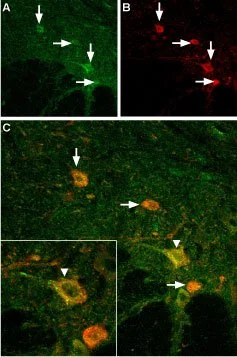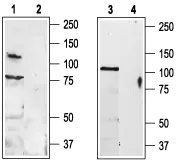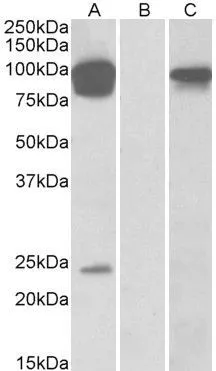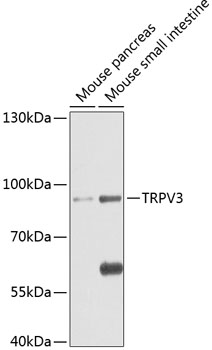
IHC-Fr analysis of mouse spinal cord tissue using GTX54763 TRPV3 antibody. The inset in panel C magnifies one large motor neuron (vertical arrowhead). Note the punctate pattern of TRPV3 on the surface of the soma. Panel A : TRPV3 (green) appears in neurons (vertical arrows) in the ventral horn of the mouse spinal cord. Panel B : Motor neurons were stained with goat anti-choline-acetyltransferase (red). In some motor neurons (A) TRPV3 was more intense (vertical arrow) whereas in others it was weak (horizontal arrows). Panel C : Merged images of panels A and B.
TRPV3 antibody
GTX54763
ApplicationsImmunoFluorescence, Western Blot, ImmunoCytoChemistry, ImmunoHistoChemistry, ImmunoHistoChemistry Frozen, Other Application
Product group Antibodies
TargetTRPV3
Overview
- SupplierGeneTex
- Product NameTRPV3 antibody
- Delivery Days Customer7
- ApplicationsImmunoFluorescence, Western Blot, ImmunoCytoChemistry, ImmunoHistoChemistry, ImmunoHistoChemistry Frozen, Other Application
- CertificationResearch Use Only
- ClonalityPolyclonal
- Concentration0.85 mg/ml
- ConjugateUnconjugated
- Gene ID162514
- Target nameTRPV3
- Target descriptiontransient receptor potential cation channel subfamily V member 3
- Target synonymsFNEPPK2, OLMS, OLMS1, VRL3, transient receptor potential cation channel subfamily V member 3, VRL-3, vanilloid receptor-like 3, vanilloid receptor-related osmotically activated channel protein
- HostRabbit
- IsotypeIgG
- Protein IDQ8NET8
- Protein NameTransient receptor potential cation channel subfamily V member 3
- Scientific DescriptionThis gene product belongs to a family of nonselective cation channels that function in a variety of processes, including temperature sensation and vasoregulation. The thermosensitive members of this family are expressed in subsets of sensory neurons that terminate in the skin, and are activated at distinct physiological temperatures. This channel is activated at temperatures between 22 and 40 degrees C. This gene lies in close proximity to another family member gene on chromosome 17, and the two encoded proteins are thought to associate with each other to form heteromeric channels. Multiple transcript variants encoding different isoforms have been found for this gene. [provided by RefSeq, Apr 2012]
- Storage Instruction-20°C or -80°C,2°C to 8°C
- UNSPSC12352203








